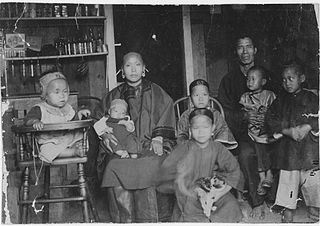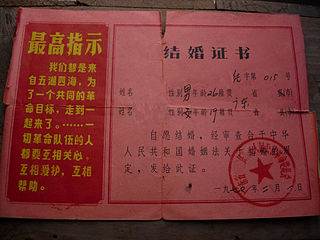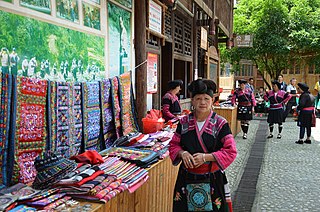Related Research Articles

Confucianism, also known as Ruism or Ru classicism, is a system of thought and behavior originating in ancient China, and is variously described as a tradition, philosophy, religion, theory of government, or way of life. Confucianism developed from what was later called the Hundred Schools of Thought from the teachings of the Chinese philosopher Confucius (551–479 BCE). Confucius considered himself a transmitter of cultural values inherited from the Xia (c. 2070–1600 BCE), Shang (c. 1600–1046 BCE) and Western Zhou dynasties (c. 1046–771 BCE). Confucianism was suppressed during the Legalist and autocratic Qin dynasty (221–206 BCE), but survived. During the Han dynasty, Confucian approaches edged out the "proto-Taoist" Huang–Lao as the official ideology, while the emperors mixed both with the realist techniques of Legalism.

Foot binding, or footbinding, was the Chinese custom of breaking and tightly binding the feet of young girls to change their shape and size. Feet altered by footbinding were known as lotus feet, and the shoes made for these feet were known as lotus shoes. In late imperial China, bound feet were considered a status symbol and a mark of feminine beauty. However, footbinding was a painful practice that limited the mobility of women and resulted in lifelong disabilities.

Mencius ; born Meng Ke ; or Mengzi was a Chinese Confucian philosopher who has often been described as the "second Sage" (亞聖), that is, second to Confucius himself. He is part of Confucius' fourth generation of disciples. Mencius inherited Confucius' ideology and developed it further. Living during the Warring States period, he is said to have spent much of his life travelling around the states offering counsel to different rulers. Conversations with these rulers form the basis of the Mencius, which would later be canonised as a Confucian classic.

The snake is the sixth of the twelve-year cycle of animals which appear in the Chinese zodiac related to the Chinese calendar. The Year of the Snake is associated with the Earthly Branch symbol 巳.

Traditional Chinese marriage is a ceremonial ritual within Chinese societies that involves not only a union between spouses but also a union between the two families of a man and a woman, sometimes established by pre-arrangement between families. Marriage and family are inextricably linked, which involves the interests of both families. Within Chinese culture, romantic love and monogamy were the norm for most citizens. Around the end of primitive society, traditional Chinese marriage rituals were formed, with deer skin betrothal in the Fuxi era, the appearance of the "meeting hall" during the Xia and Shang dynasties, and then in the Zhou dynasty, a complete set of marriage etiquette gradually formed. The richness of this series of rituals proves the importance the ancients attached to marriage. In addition to the unique nature of the "three letters and six rituals", monogamy, remarriage and divorce in traditional Chinese marriage culture are also distinctive.
Women's health in China refers to the health of women in People's Republic of China (PRC), which is different from men's health in China in many ways. Health, in general, is defined in the World Health Organization (WHO) constitution as "a state of complete physical, mental, and social well being and not merely the absence of disease or infirmity". The circumstance of Chinese women's health is highly contingent upon China's historical contexts and economic development during the past seven decades. A historical perspective on women's health in China entails examining the healthcare policies and its outcomes for women in the pre-reform period (1949-1978) and the post-reform period since 1978.

Yu Zhengxie (1775–1840) was a Qing dynasty scholar from Yi county in modern-day Anhui province. Along with his philological work, he was a noted critic of foot binding, female infanticide, and the cult of widow chastity.

The All-China Women's Federation is a women's rights people's organization established in China on 24 March 1949. It was originally called the All-China Democratic Women's Foundation, and was renamed the All-China Women's Federation in 1957. It has acted as the official leader of the women’s movement in China since its founding. It is responsible for promoting government policies on women, and protecting women’s rights within the government, while liberating them from traditional norms within society and involving them in social revolution with the aim to promote their overall status and welfare in Chinese society. As a united political community, women in the ACWF achieved political momentum, power among the male elite, and required representation.

The Chinese kinship system is among the most complicated of all the world's kinship systems. It maintains a specific designation for almost every member's kin based on their generation, lineage, relative age, and gender. The traditional system was agnatic. based on patriarchal power, patrilocal residence, and descent through the male line. Although there has been much change in China over the last century, especially after 1949, there has also been substantial continuity.

Empress Xiaozheyi, of the Manchu Bordered Yellow Banner Arute clan, was a posthumous name bestowed to the wife and empress consort of Zaichun, the Tongzhi Emperor. She was empress consort of Qing from 1872 until her husband's death in 1875, after which she was honoured as Empress Jiashun.

Like women in many other cultures, women in China have been historically oppressed. For thousands of years, women in China lived under the patriarchal social order characterized by the Confucius teaching of "filial piety". In modern China, the lives of women have changed significantly due to the late Qing dynasty reforms, the changes of the Republican period, the Chinese Civil War, and the rise of the People's Republic of China (PRC).
Patriarchy is a social system in which positions of dominance and privilege are held by men. The term patriarchy is used both in anthropology to describe a family or clan controlled by the father or eldest male or group of males, and in feminist theory to describe a broader social structure in which men as a group dominate women and children.

Bama Yao Autonomous County is a county in Guangxi, China. It is under the administration of Hechi City. The residents of Bama County have a reputation for longevity, and Bama has been the focus of studies from geriatricians nationwide.

The New Marriage Law was a civil marriage law passed in the People's Republic of China on May 1, 1950. It was a radical change from existing patriarchal Chinese marriage customs, and needed constant support from propaganda campaigns. It has since been superseded by the Second Marriage Law of 1980. It was formally repealed by the Civil Code in 2021.
Women in ancient and imperial China were restricted from participating in various realms of social life, through social stipulations that they remain indoors, whilst outside business should be conducted by men. The strict division of the sexes, apparent in the policy that "men plow, women weave", partitioned male and female histories as early as the Zhou dynasty, with the Rites of Zhou, even stipulating that women be educated specifically in "women's rites". Though limited by policies that prevented them from owning property, taking examinations, or holding office, their restriction to a distinctive women's world prompted the development of female-specific occupations, exclusive literary circles, whilst also investing certain women with certain types of political influence inaccessible to men. Women had greater freedom during the Tang dynasty, however, the status of women declined from the Song dynasty onward, which has been blamed on the rise of neo-Confucianism, and restrictions on women became more pronounced.

In 2021, China ranked 48th out of 191 countries on the United Nations Development Programme's Gender Inequality Index (GII). Among the GII components, China's maternal mortality ratio was 32 out of 100,000 live births. In education 58.7 percent of women age 25 and older had completed secondary education, while the counterpart statistic for men was 71.9 percent. Women's labour power participation rate was 63.9 percent, and women held 23.6 percent of seats in the National People's Congress. In 2019, China ranked 39 out of the 162 countries surveyed during the year.
Sheng nu is a term popularized by the All-China Women's Federation that classifies women who remain unmarried in their late twenties and beyond. Most prominently used in China, the term has also been used colloquially to refer to women in India, North America, Europe, and other parts of Asia. The term compares unmarried women to leftover food and has gone on to become widely used in the mainstream media and has been the subject of several television series, magazine and newspaper articles, and book publications, focusing on the negative connotations and positive reclamation of the term. While initially backed and disseminated by pro-government media in 2007, the term eventually came under criticism from government-published newspapers two years later. Xu Xiaomin of The China Daily described the sheng nus as "a social force to be reckoned with" and others have argued the term should be taken as a positive to mean "successful women". The slang term, 3S or 3S Women, meaning "single, seventies (1970s), and stuck" has also been used in place of sheng nu.

Postpartum confinement is a traditional practice following childbirth. Those who follow these customs typically begin immediately after the birth, and the seclusion or special treatment lasts for a culturally variable length: typically for one month or 30 days, 26 days, up to 40 days, two months, or 100 days. This postnatal recuperation can include care practices in regards of "traditional health beliefs, taboos, rituals, and proscriptions." The practice used to be known as "lying-in", which, as the term suggests, centres on bed rest. In some cultures, it may be connected to taboos concerning impurity after childbirth.

Widow chastity was an ideal in traditional Chinese cultural practices and beliefs that honored widowed women and discouraged their remarriage, encouraging them instead to live a life of "virtuous chastity". The idea of widow chastity has a long history in China, but the emphasis on the practice is believed to have its origin among Song dynasty Neo-Confucians, and reached a culmination and eventual end in the Qing era.
Virtue schools, or female virtue classes are privately operated schools or classes in the People's Republic of China that have become controversial for allegedly teaching women so-called traditional Chinese virtues, such as being obedient and subordinate to men.
References
- ↑ Joanne D. Birdwhistell (2007). Mencius and Masculinities: Dynamics of Power, Morality, and Maternal Thinking. SUNY Press. ISBN 978-0-7914-8038-0 . Retrieved 31 July 2013.
- ↑ Chen, F. (2005). "Residential patterns of parents and their married children in contemporary China: A life course approach". Population Research and Policy Review . 24 (2): 125–148. doi:10.1007/s11113-004-6371-9. S2CID 71709934.
- ↑ Tatlow, Didi Christian; Forsythe, Michael (20 February 2015). "In China's Modern Economy, a Retro Push Against Women". The New York Times .
- ↑ Magistad, Mary Kay (20 February 2013). "BBC News - China's 'leftover women', unmarried at 27". BBC News . Beijing. Retrieved 29 March 2013.
- ↑ Schiavenza, Matt (16 September 2013). "The Peculiar History of Foot Binding in China". The Atlantic .
- ↑ Fong, Mei (5 January 2016). One Child.
- 1 2 Lary, Diana (2022-04-30). China's Grandmothers: Gender, Family, and Ageing from Late Qing to Twenty-First Century (1 ed.). Cambridge University Press. p. 14. doi:10.1017/9781009064781. ISBN 978-1-009-06478-1. S2CID 248187455.
- 1 2 Lary, Diana (2022-04-30). China's Grandmothers: Gender, Family, and Ageing from Late Qing to Twenty-First Century (1 ed.). Cambridge University Press. p. 27. doi:10.1017/9781009064781. ISBN 978-1-009-06478-1. S2CID 248187455.